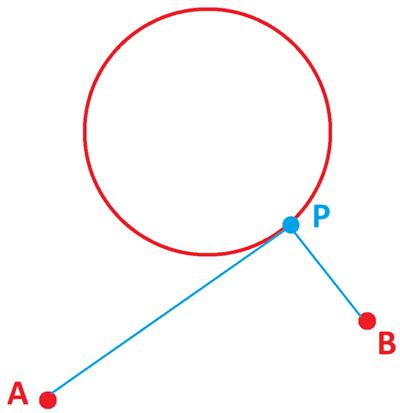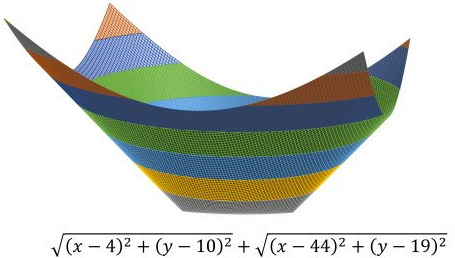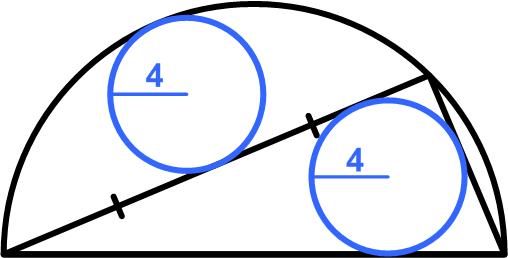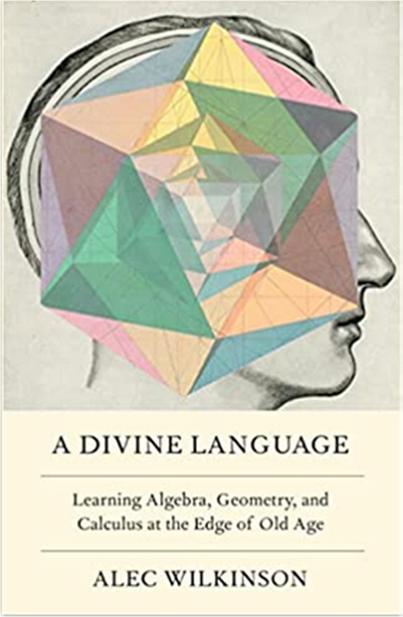 Here is another elegant Quantum math magazine Brainteaser problem.
Here is another elegant Quantum math magazine Brainteaser problem.
“Two squares are inscribed in a semicircle as shown in the figure at left. Prove that the area of the big square is four times that of the small one.”

 Here is another elegant Quantum math magazine Brainteaser problem.
Here is another elegant Quantum math magazine Brainteaser problem.
“Two squares are inscribed in a semicircle as shown in the figure at left. Prove that the area of the big square is four times that of the small one.”
 James Tanton provides another imaginative problem on Twitter.
James Tanton provides another imaginative problem on Twitter.
“I am at point A and want to walk to point B via some point, any point, P on the circle. What point P should I choose so that my journey A → P → B is as short as possible?”
Hint: I got ideas for a solution from two of my posts, “Square Root Minimum” and “Maximum Product”.
 This seemingly impossible problem from Presh Talwalkar turned out to be quite solvable upon reflection.
This seemingly impossible problem from Presh Talwalkar turned out to be quite solvable upon reflection.
“A similar question was given to students in Thailand. For real numbers x, y, what is the minimum value of
√((x – 4)2 + (y – 10)2) + √((x – 44)2 + (y – 19)2)”
See the Square Root Minimum for solutions.
 Via Alex Bellos I found another Russian math magazine with fun problems. It is called Kvantik and Tanya Khovanova has a description (2015):
Via Alex Bellos I found another Russian math magazine with fun problems. It is called Kvantik and Tanya Khovanova has a description (2015):
“Kvant [Quantum] was a very popular science magazine in Soviet Russia. It was targeted to high-school children and I was a subscriber. Recently I discovered that a new magazine appeared in Russia. It is called Kvantik, which means Little Kvant. It is a science magazine for middle-school children. The previous years’ archives are available online in Russian. I looked at 2012, the first publication year, and loved it.”
Unfortunately, the magazine is in Russian and the later issues are only partially given online. To get the full magazine you need to subscribe. I used Google Translate and the mathematical context to render the English. Here is an interesting geometric problem that I would have thought to be quite challenging for middle schoolers.
“The vertices of the two squares are joined by two segments, as in the figure. It is given that these segments are equal. Find the angle between them.
Egor Bakaev”
See the Two Squares Problem for a solution.
(Update 8/22/2022, 9/1/2022) Simpler Solution, Simplest Solution!
Continue reading
 Here is a problem from the 2022 Math Calendar.
Here is a problem from the 2022 Math Calendar.
“Two small circles of radius 4 are inscribed in a large semicircle as shown. Find the radius of the large semicircle.”
As before, recall that all the answers are integer days of the month.
As seemed to be implied by the original Math Calendar diagram, I made explicit that the upper circle was tangent to the midpoint of the chord. Otherwise, the problem is insufficiently constrained.
See Two and a Half Circles for a solution.
 I have just finished reading a most remarkable book by Alec Wilkinson, called A Divine Language: Learning Algebra, Geometry, and Calculus at the Edge of Old Age. I had read an essay of his in the New Yorker that turned out to be essentially excerpts from the book. I was so impressed with his descriptions of mathematics and intrigued by the premise of a mature adult in his 60s revisiting the nightmare of his high school experience with mathematics that I was eager to see if the book was as good as the essay. It was, and more.
I have just finished reading a most remarkable book by Alec Wilkinson, called A Divine Language: Learning Algebra, Geometry, and Calculus at the Edge of Old Age. I had read an essay of his in the New Yorker that turned out to be essentially excerpts from the book. I was so impressed with his descriptions of mathematics and intrigued by the premise of a mature adult in his 60s revisiting the nightmare of his high school experience with mathematics that I was eager to see if the book was as good as the essay. It was, and more.
The book is difficult to categorize—it is not primarily a history of mathematics, as suggested by Amazon. But it is fascinating on several levels. There is the issue of a mature perspective revisiting a period of one’s youth; the challenges of teaching a novice mathematics, especially a novice who has a strong antagonism for the subject; and insights into why someone would want to learn a subject that can be of no “use” to them in life, especially their later years.
Wilkinson has a strong philosophical urge; he wanted to understand the role of mathematics in human knowledge and the perspective it brought to life. He was constantly asking the big questions: is mathematics discovered or invented, what is the balance between nature and nurture, why does mathematics seem to describe the world so well, what is the link between memorization and understanding, how do you come to understand anything?
 Henk Reuling posted a deceptively simple-looking geometric problem on Twitter.
Henk Reuling posted a deceptively simple-looking geometric problem on Twitter.
“I found this old one cleaning up my ‘downloads’ [source unknown] I haven’t been able to solve it, so help!
According to the given information in the figure, what is the length of the missing interval on the diagonal of the square?”
See the Missing Interval Puzzle for solutions.
 This math problem from Colin Hughes’s Maths Challenge website (mathschallenge.net) is a bit more challenging.
This math problem from Colin Hughes’s Maths Challenge website (mathschallenge.net) is a bit more challenging.
“In the diagram, AB represents the diameter, C lies on the circumference of the circle, and you are given that
(Area of Circle) / (Area of Triangle) = 2π.
Prove that the two smaller angles in the triangle are exactly 15° and 75° respectively.”
See the 15 Degree Triangle Puzzle

This is a thoughtful little problem from Posamentier’s and Lehmann’s Mathematical Curiosities.
“We have nine wheels touching each other with diameters successively increasing by 1 cm. Beginning with 1 cm as the smallest circle, and 9 cm for the largest circle, how many degrees does the largest circle turn when the smallest circle turns by 90°?”
See the Turning Wheels Puzzle for solutions.